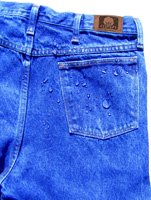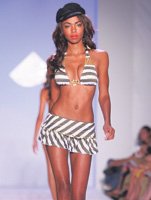High-tech and recycled fabrics are beginning to take fashion forward
High-tech and recycled fabrics are beginning to take fashion forward.
AWater-resistant Storm Denim, developed by Cotton Inc., is just one of many new technical fabrics coming to a store—and person—near you. According to an NPD Fashionworld study, the amount of apparel with performance attributes will increase from 25 percent to 50 percent over the next few years. And already performance fabrics are migrating from the outdoor and athleticwear market segments into mainstream apparel, foreshadowing a not-too-distant future when our clothes may not resemble “Star Trek” spandex suits but have qualities bordering on science fiction.
Storm Denim, created a year ago by Cotton Inc.’s Textile Chemistry department, is based on a topical treatment applied at the final stage of manufacturing, so as not to interfere with the garment’s design. The result is denim that is highly water repellent without sacrificing the fabric’s natural breathability.
This means that Storm Denim can be worn comfortably indoors, unlike other waterproof items that quickly become hot and clammy, says Bill Rearick, Cotton Inc.’s director of finishing research and global product supply chain.
Though Storm Denim has yet to hit retail stores, Rearick has seen “a lot of interest” in the technology, and several hush-hush manufacturers are developing denim’s next generation.
Water resistance isn’t the only innovation coming to everyone’s favorite fabric. This year, Wrangler released a jean with Durashield, another Cotton Inc. innovation. Durashield’s denim fabric fibers actually move during wear and laundering, much like ball bearings, to reduce abrasion and protect coloring. This may sound anathema in an age of distressed and destroyed denim, “but what we believe the consumer wants is to keep the old look but not have the garment wear out,” says Rearick.
Similarly, Cotton Inc.’s Tough Cotton, used in pants like khakis and capris, resists abrasion at crucial points, such as around cuffs, creases, and pockets. Combine this with other popular performance attributes like stain and wrinkle resistance, and cotton trousers might soon be practically indestructible while still retaining all their comfort. “There’s going to be more combination finishes, and innovation will occur by creating more performance features in single fabrics,” says Rearick. “It’s been a trend over the last decade or so, and it’s likely to escalate because there’s just an awful lot of things possible with current technology.” Stretching the nvelope Invista, which markets Lycra fabrics, has long been at the forefront of performance fabric innovation. This summer, it introduced its latest Lycra creation aimed at the swimwear industry, Xtra Life, which appeared in more than 15 swimwear collections. Xtra Life provides a longer-lasting fit by helping swimwear resist bagging and sagging. The new fabric is also five to ten times more resistant to chlorine than typical elastane and delivers enhanced protection against shape loss when wet.
Lycra is commonly used in denim to provide stretch, and at New York Olympus Fashion Week earlier this month, Invista unveiled its latest Lycra applications for denim. Xfit Lycra is a cross-weave technology that delivers four-way stretch properties for superior fit, while Lycra T400 allows designers to employ a variety of aggressive washes and abrasions without sacrificing the comfort and fit that Lycra provides. The innovations have already been adopted by top denim manufacturers, including Derek Lam, Rock & Republic, Serfontaine and Zac Posen.
Crossing over As with denim, performance fabrics are not only becoming more varied and mainstream, they’re also becoming more subtle, often disguised in clothing that looks traditional but is in fact high-tech. Vancouver, Canada–based Arc’teryx began as an outdoor equipment company before branching out into outdoorwear aimed at ice climbers. One of its most popular items is a collection of sweaters called Covert (retail price $150), which utilize Polartec, a yarn designed by Malden Mills that provides warmth without bulk. “It’s very high performance,” says Malden Mills spokesman Greg Williams of the Arc’- teryx Covert collection, “the lightest, warmest piece you could possibly wear, yet it looks like a traditional sweater.”
For Spring 2007, Arc’teryx will continue to offer more mainstream clothing—cotton canvas pants, polo shirts, women’s capris— that incorporate the same performance attributes of its outdoorwear. Polo shirts will use a fabric called Invigor that is “papertowel thin” with both wrinkle-resistance and moisture-management properties.
Polartec is the main product of Lawrence, Mass.’s Malden Mills, which turns 100 years old this year. Polartec consists of 300 fabrics in seven performance categories, including insulation, wicking and weatherproofing. Though it mostly supplies fabric for outdoor brands like Patagonia, The North Face, and LL Bean, “We’ve found some success in the crossover market,” says Williams. “Not huge yet, but that’s where we’re seeing growth—in the more everyday lifestyle fashion world.”
Eco-Tech Outdoor apparel companies with extensive performance products are also driving the market for recycled fabrics, because in the outdoor sphere the consumer sees performance and recycled fabrics as “hand in hand,” says Greg Williams of Arc’teryx.
In January, Malden Mills debuted 20 new recycled fabrics throughout its various Polartec categories. Recycled fabrics represent “the direction companies like Patagonia are going,” says Williams, adding that Patagonia plans to have its line made entirely from recycled fabrics by 2010.
Patagonia has already released a collection of men’s and women’s zip-tops, men’s crewnecks, and women’s hoodies and tights called Capilene 4, which, it says, is “a breakthrough in recycled-fabric technology with next-generation softness and wicking performance made from recycled content.” The Capilene 4 collection is also 100 percent recyclable through Common Threads, a program in which old polyester garments are donated at Patagonia stores and recycled into new garments.
For Malden Mills, the enthusiastic response to recycled Polartec “bowled us over,” says Williams. In 2007, Patagonia, LL Bean, and REI will all introduce new products made from recycled Polartec, with the same price and performance level of virgin polyester. And starting next year, LL Bean’s popular Trail Model Fleece collection will be entirely made of recycled Polartec, “a huge endorsement,” says Williams.
In summer 2006, in conjunction with Malden Mills, Greensboro, N.C.–based yarn manufacturer Unifi released a family of performance fabrics called Repreve made from recycled post-industrial fiber waste and post-consumer plastics, which are melted and reformulated into a chip turned into yarn via a proprietary process. Not only does it use recycled materials, it requires less energy to produce than virgin polyester. The response, says marketing manager Brett Anderson, was phenomenal, because “consumers are ready for the eco-friendly image.”
Repreve is just one yarn in Unifi’s quiver of performance fabrics. Eighteen months ago, Unifi released a family of yarns called AIO, an All in One yarn that can be custom-made with multiple performance attributes, including odor control, UV protection, performance stretch, and moisture management. Unifi has also combined the technologies of recycled and performance yarns “so that retailers and manufacturers don’t have to sacrifice performance to get their eco story.”Getting intimate Not just outerwear brands are pushing performance. Unifi is seeing increasing interest in anti-microbial yarns for odor control and a “clean feeling,” such as with Glamorise, an intimate apparel company offering performance bras.
This fall, Chantilly, V.A.–based women’s athleticwear brand Moving Comfort released two sports bras using Unifi’s moisture-management product, Sorbtek.
While all of Moving Comfort’s collection includes performance properties, the company decided to introduce Sorbtek after seeing a demonstration in which it outperformed competing fabrics. “It moves moisture away from the body quickly and evaporates more quickly,” says Audrey Kirkland, Moving Comfort’s senior manager of design for bras.
Kirkland believes that performance will increasingly be utilized in everyday intimate apparel. “Many women use our sports bras as their everyday bra,” she says. Other sports bras in Moving Comfort’s collection even incorporate stretch Lycra lace for added lingerie sexiness, while still offering moisture management and support for activity.
Longmont, Colo.–based Traptek has found a novel way of tapping into the consumer’s growing desire for ecofriendly apparel. Founded in 2000 by Gregory Haggquist, who holds a PhD in composite chemistry, Traptek has developed a natural performance fabric treatment made from coconut shells, appropriately trademarked Cocona.
Haggquist had originally set out to create an odor-absorbing fabric using activated carbon, long known to have purification properties. He found that coconut shell–activated carbon worked well for hardness and pore size, into which the odor molecules fall and get trapped until washed out. But he acci-dentally found it had tremendous wicking and UV protection properties as well.
Cocona is a proprietary natural treatment used on garments at the molecular level. Traptek intends to provide the treatment to different fabric manufacturers.
Though Cocona is used on polyester, nylon, and polymer fabrics, these can be blended with cotton and will retain a cotton garment’s features of stretch and washability.
After a workout, Cocona will leave you smelling fresh, though hardly like a pintilde;a colada. Playing tennis in a shirt treated with Cocona, for example, “You’d sweat during your match, then afterwards, as you’re cooling down, your shirt would dry rather quickly—within five to ten minutes,” says Haggquist. “And then no one would know that you’d worked out. You wouldn’t have a strong odor emanating from your body and clothing.”
As for Cocona’s performance, Haggquist says many competing fabrics and treatments offer wicking but not quick-drying properties. And Cocona adsorbs odors—or not absorbs them—meaning it traps odors at the molecular level, which Haggquist says provides much better performance than odormasking anti-microbial fabrics.
Bicycle-apparel company Cannondale is already on market with Cocona. In 2007, Haggquist says 28 apparel companies, including athleticwear brand Champion, will release apparel bearing a Cocona hangtag.
Though he can’t reveal names, the list includes everyday clothing brands with all manner of apparel items.
Performance fabrics not only offer comfort during workouts and outdoor excursions, warmth in the winter and odor control on balmy days, but they also address the hectic lifestyle of today’s consumer.
Doing the Laundry 3M’s stain-repellent Scotchgard—a timehonored treatment on everything from sofas to dog beds—has also long been used on men’s dress shirts, polos, and pants, plus childrenswear. Scotchgard caters to time-strapped people of today who want “clothes that are easy to take care of and that are going to look good for a long time,” says Scotchgard global business manager Ben Marcovitch.
Scotchgard’s latest innovation is called Dual Action Repel and Release, which both repels stains and helps release any remaining soil when the garment is laundered. Scotchgard treatments are administered at the final stage of garment manufacturing, and for fairly little cost. “It’s a very nominal amount of cost to the mill, and while they certainly have to pass that on, by the time it gets to retail it’s very small,” says Marcovitch.
Marcovitch also concurs that today’s consumer wants multiple performance features in one garment. Scotchgard is addressing this by offering a treatment combining moisture management with stain release.
“Homemakers are looking at what they can do to make their lives easier and save time.”
























